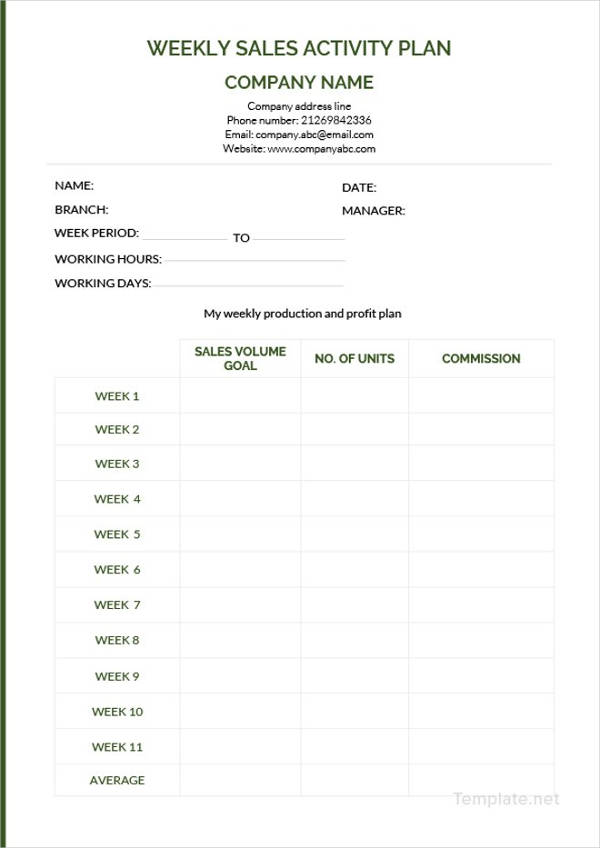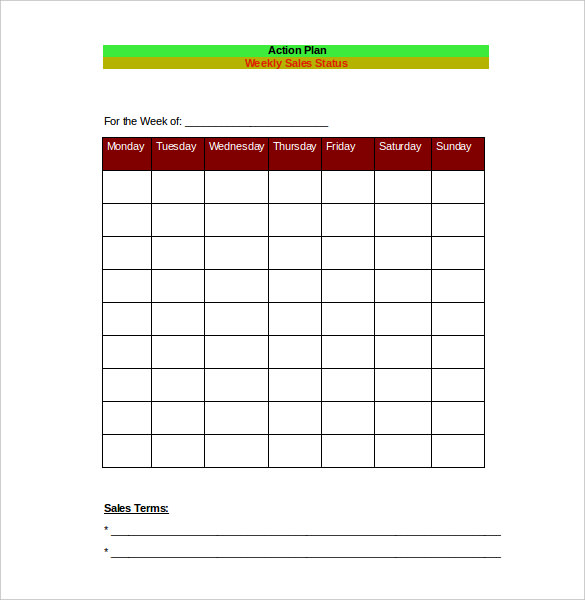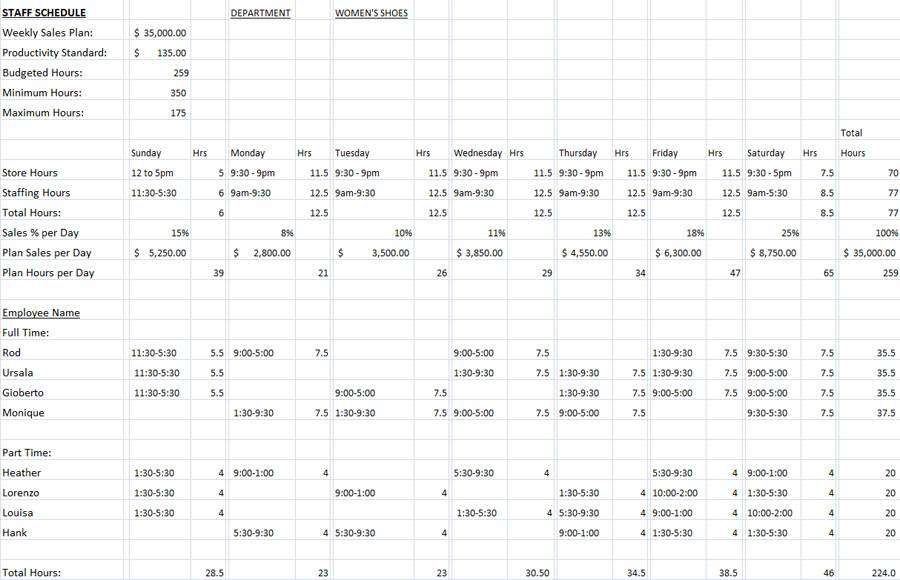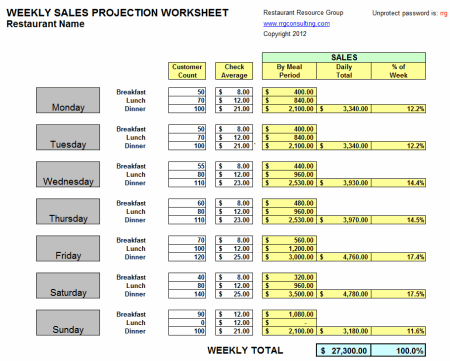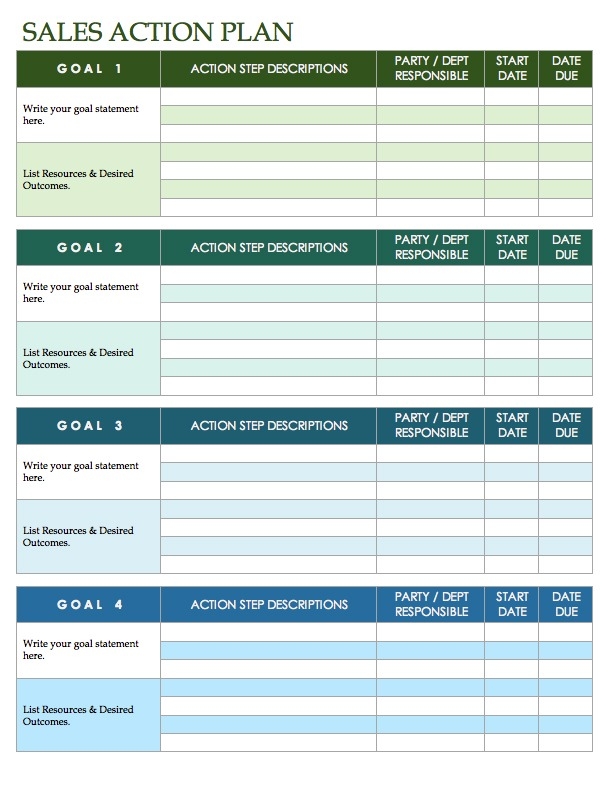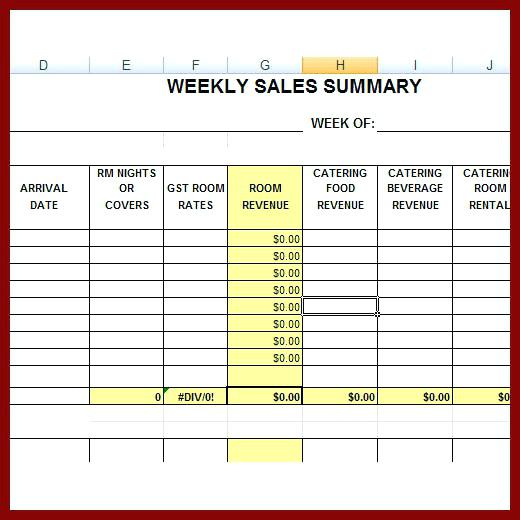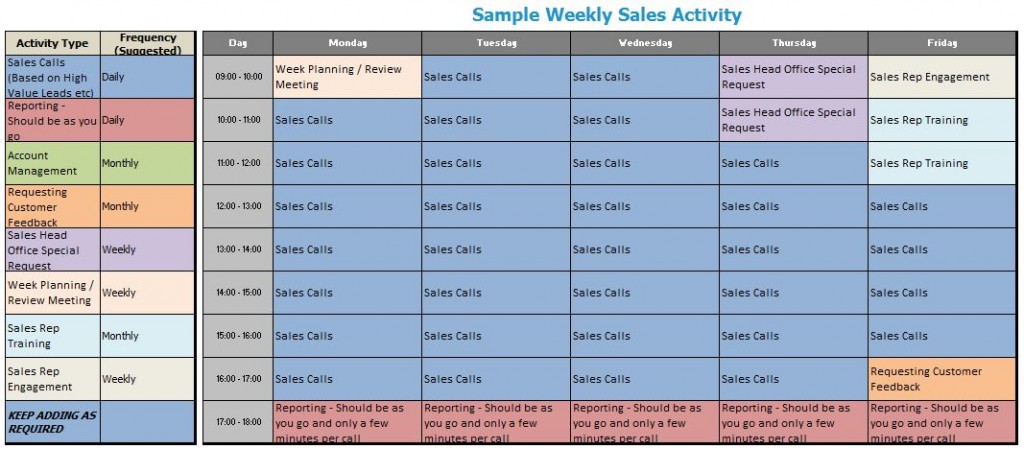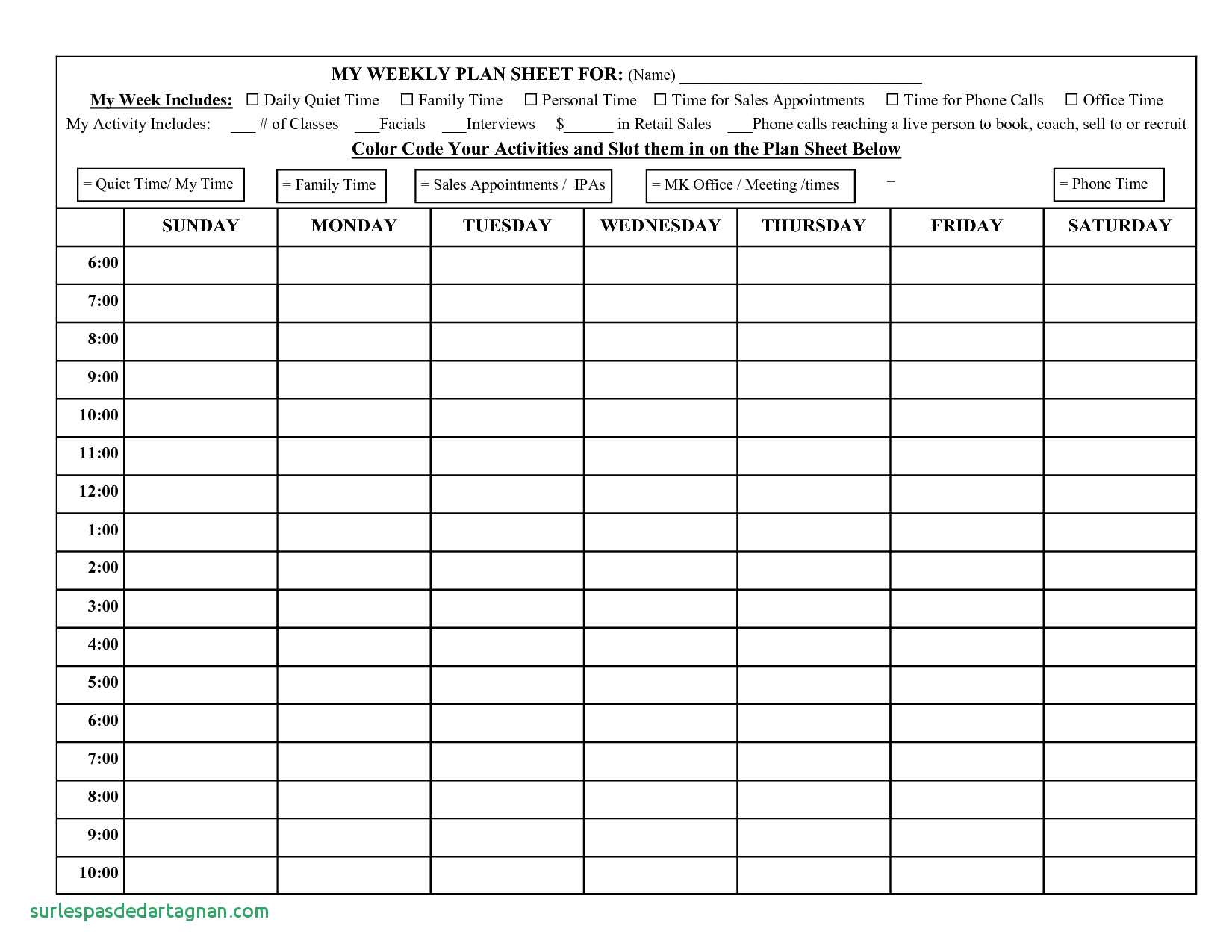9+ Weekly Sales Plan Examples to Download
A sales plan is a document that serves as a medium for strategizing your sales goals and objectives, while effectively communicating your tactics to your team to help you achieve these targets. It’s an indispensable tool in achieving short-term goals that can lead to reaching and exceeding your long-term expectations.
Weekly Sales Plan Template Example
A sales plan will lay out your objectives, approaches, target audience, and potential obstacles. Sounds familiar? That’s because a sales plan works almost the same way as a business plan. The only difference is that this instrument is specifically designed to cater to your sales strategy.
Weekly Sales Plan Example

Weekly Sales Activity Plan Example
Whether you are creating a road map for your team, or contriving for your own growth, a weekly sales plan will help you solidify your professional goals, maintain your motivation in attaining them, and pursue continued success in your field of expertise.
Weekly Sales Plan Status
Why You Need a Weekly Sales Plan
Have you ever tried grocery shopping? Are you one of those people who just randomly go to the supermarket, grab whatever they can find, and then go home only to realize that they’ve forgotten to grab a new carton of milk or a roll of tissues? So they’re going to have to drive all the way back to the store to grab two essential things they forgot simply because they didn’t create a list of what they need. You may also see sales strategy plan examples.
Or even when you’re driving to some place you’ve never been to. You don’t just start your engine and hope for the best. You’ll have to ask for directions and landmarks, or find the location on your GPS to assure that you get there. Unless you want to lose a couple of hours off your time getting lost, then be everybody’s guest. You may also like daily sales plan examples.
Your sales plan is not that different from a grocery list or a map for an unfamiliar road. Not only will it help make sure you actually get what and where you set your eyes on, it will also make the attempt more efficient because you have already planned the whole process.
The competitiveness of the corporate world can be overwhelming. Achieving goals you’ve set out for your team is already difficult in itself. If you add the rivals into the equation, it can be pretty daunting. If you make your way through it with no direction or guide whatsoever, not only will you fail to get anywhere meaningful, you might also get lost.
The unadulterated act of writing your goals on paper gives it more weight, more significance. It also gives you more focus, in comparison to simply trying to maintain a mental picture of the things that you want to gain. In this technology-ruled generation, something as important as your better goal must deserve to be written down.
Having a target you can work toward is excellent because it can serve as your motivation. But backing that up with a plan? It’s 90% chance of success. Having a printed out weekly sales plan can give you the focus of a shopping list and the efficiency of a map.
Annual and quarterly sales plans are also valuable but they tend to look at the bigger picture more. This can become a liability since it’s the small steps that serves as a catalyst for the long-term goals to be achieved. A weekly sales plan is every successful salesperson’s secret weapon. They will use it to declare exactly what they intend to get done, and how they can do it, over the short time span of seven days.
With a weekly sales plan, you can also make the most out of your weekend knowing that your five days has been successful, and that the next week has already been prepared for. Who doesn’t want that kind of assurance?
Weekly Sales Plan Sample Template
Weekly Sales Plan Projection Worksheet
Three Ways to Start Your Sales Week
The best way to maximize your five days is to already have an idea on what you can use it for, keeping in mind that every action must be dedicated to attaining the best possible long-term results. Here are three things you can choose to do with your week to make the best out of it:
1. Begin with Your Existing Opportunities
On a positive note, you don’t have to start with a completely empty plate because you already have an existing pipeline to work with. It’s now up to you to utilize these resources to help you move either forward or backward. You may also see territory sales plan examples.
Working backward would mean that you grab the opportunities that have presented themselves to you, such as a phone call, an email, or a meeting to an important entity, and use them to help you move forward.
By using your assets and injecting the right amount of commitment, you’ll create a faster route to the end of the sales process. This is an effective technique that can help you make sure that you’ve taken every possible action to move forward. You may also like monthly sales plan examples.
By taking these opportunities and moving them forward at the dawn of the sales process, you can effectively gain commitments while also using the ones you already have.
2. Begin by Creating New Opportunities within Your Existing Clients
Another option you can develop on is the chance to create new opportunities with the help of your patrons. Use these existing relationships to make new opportunities. Doing so will be easier since you already have the people and the contracts, the only thing left for you to do is to take these connections to create bigger value. You may also check out sales strategic plan examples.
3. Begin by Prospecting and Nurturing Your Dream Clients
The final and, honestly, the best choice out of the three is to begin your week with the intention of focusing on your dream clients or your desired market bunch. However, this can be pretty difficult, even for founded salespeople, and especially for those who are new to the field. You might be interested in hotel sales plan examples.
These clients aren’t yours (yet) because of two reasons: first, they don’t know who you are, which can be easily amended; second, they don’t care about you, and there lies the challenge. These prospective clients are going to be cold toward you. And since you don’t have a current relationship with them, nor do you have any existing opportunities where they are concerned, the going will get tough. You may also see restaurant sales plan examples.
However, by focusing on these prospects first, and investing your whole week’s worth of efforts to attract them, the higher your chances are of getting things done.
When it comes to your clients, also known as the most important people in your business life, you have two choices (again): working with the ones who are already loyal to you or trying to market to those who you are yet to attract. If you choose the former, chances are that you will no longer have time for the latter. You may also like printable strategic sales plan examples.
Know your priorities (which is basically the lesson this whole article is trying to communicate) and work on them. But if you feel that you need to implement both choices on your week, do so. Take the day’s first half for one, and the rest for the other. Although this can prove itself to be a challenge, it will also help you achieve more, thus making your week productive. You may also check out sales action plan examples.
Taking the time to think about how you’re going to utilize your upcoming week will help you know the priorities you should focus all your energy on. Doing so will help you achieve small benchmarks that are helpful in reaching your bigger goals. You might be interested in financial plan examples.
Weekly Sales Action Plan Guide
Weekly Sales Plan Summary
How to Develop a Weekly Sales Plan
Once you’ve decided how to make use of your week, you can then proceed to creating a plan that can outline your goals and the steps you can take to reach them. Whether you are a sales manager curating a plan for your team members, or a team member developing a sales plan for yourself, the benefits that this tiny, yet resounding, effort can offer are numerous.
Especially as a salesperson who must be continually self-motivated and driven to ensure an active pursuance of success rather than simply lying in wait until it comes, a weekly sales plan is an absolute need. Which is why below are six steps you can follow to help you design a simple sales plan that can specifically cater to your needs and goals.
1. Determine your sales goals.
Your goals will serve as the starting point which can guide you and tell you how to develop your sales plan. Without a clear and definite aim, even with an effective sales plan, you’ll still drift aimlessly since you don’t really have a destination in mind. (What’s a map or a GPS if you don’t have a place you want to go?) You may also see marketing plan examples.
Your goal can be something small or common like a targeted sales volume or a dollar amount. As unoriginal as these targets are, they can already tell you how hard you have to work and how many sales you need to get to attain your goal.
2. Select the system or strategy most effective in achieving your goal.
Each of the products you are trying to sell needs different marketing strategies. What may help you sell a car may not do you any good when trying to advertise an insurance policy. Once you’ve understood the number or amount you are aiming for, narrow down the best methods in your field and identify which one will be most helpful to you in making sales.
3. Define your target market and develop a sales plan for it.
Get to know your product as well as your customers. Then, connect both parties and see where they match somehow. Determine how your product can meet your customers’ needs, and demonstrate that to them in a way they can never refuse. By understanding the most pertinent needs of your prospects, you can present your product to them in a way that will make them think that it is the answer to their demands. You may also like advertising plan examples.
4. Set a daily target for the number of potential customers you must engage.
If you have an idea of the typical closing ratio for your business, use that number to determine how many prospects you need to see and how many chances of closing a deal you need to create to meet your target. For example, your average closing rate is one out of five. If your goal is two customers a day, then you would need to engage with at least ten people to get the chance of acquiring those two sales. You may also check out marketing strategy plan examples.
Sales is a numbers game. Oftentimes, it only takes a thorough understanding of the figures relevant to your sales goals and finding the required number of prospects to get to the number you are aiming for, and more.
5. Create a rewards system for meeting goals.
Although closing a deal is already a sweet reward in itself, salespeople need something a little more substantial than that. (We all do.)
If you are a manager, offering incentives to your hardworking team can motivate them to propel harder toward meeting your weekly sales goal. If you are a salesperson who just achieved her quota, pat yourself on the back and treat yourself to something. This can keep you inspired to work even harder. You might be interested in real estate development marketing plan examples.
6. Chart your progress and keep careful records.
By writing your goal down and reviewing it daily, you can achieve a practiced focus that will keep you moving forward. Also, it will let you know just how much you have improved or slackened. Keeping record of your own performance will help you assess yourself, and who’s a better critic of you than you? You may also see business development strategy plan examples.
Sample Weekly Sales Activity Plan
My Weekly Sales Plan Sheet
The most important aspect of a weekly sales plan is understanding where you want to find yourself in at the end of the week. Once you’ve identified this, you can then start working to get there. But the excursion will no longer be so difficult because you already have a sketch of how you can arrive at your destination. Perks, right? You may also see action plan examples.




